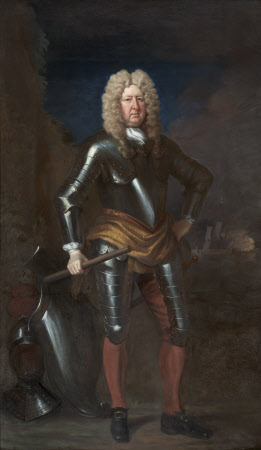Admiral Sir Ralph Delaval, RN (c.1641 - 1706/07)
Michael Dahl (Stockholm 1659 - London 1743)
Category
Art / Oil paintings
Date
circa 1702
Materials
Oil on canvas
Measurements
2362 x 1448 mm (93 x 57 in)
Place of origin
England
Order this imageCollection
Seaton Delaval Hall, Northumberland
NT 1276764
Caption
Ralph Delaval began his naval career under the Duke of York (later James II), but flourished under William of Orange, becoming one of the admirals who jointly commanded the fleet, with Henry Killigrew and Cloudesley Shovell. However, ‘Notorious and treacherous mismanagement’ was alleged in the Commons, and Delaval was forced to retire to Northumberland. He was buried in Westminster Abbey, in one of the earliest naval tombs there. The picture bears many similarities with Dahl's portrait of Admiral Sir Cloudesley Shovell (1650 – 1707), in the National Maritime Museum. Given that the two sitters served as joint commanders of the fleet, it seems conceivable that the commissions were placed in tandem, or at least one in the knowledge of the other. The Shovell portrait is signed and dated 1702, which suggests a similar dating for the Seaton picture.
Summary
Oil painting on canvas, Admiral Sir Ralph Delaval, R.N. (c.1641 - 1706/07) by Michael Dahl (Stockholm 1656/9 – London 1743). Full-length, standing, wearing armour and holding a baton, his helmet and shield bottom left, a naval engagement beyond.
Full description
From the junior branch of the Delaval family, born at North Dissington, Ponteland, an estate which he ultimately inherited, and later sold to Edward Collingwood of Byker in 1673. He began his naval career under the Duke of York (later James II), serving in the Second and Third Dutch Wars, commanding the ‘Constant Warwick’ in 1674. In 1688 he had command of the ‘York’ and supported William of Orange at the Revolution. He directed the blue squadron with distinction at the action off Beachy Head in 1690. During the winter of 1691-92 he blockaded Dunkirk. Delaval was Vice-Admiral of the Red squadron at Barfleur and destroyed the French flagship Soleil Royal and two other French warships at Cherbourg. He commanded the rear squadron at La Hogue, 1692 (his logbooks for HMS Royal Sovereign [1691 – 1693] are preserved in the archives of the New York Public Library). In January 1693, he was appointed one of the admirals who jointly commanded the fleet with Henry Killigrew and Cloudesley Shovell, replacing Edward Russell. However, he was severely criticised following the severe damage inflicted on the Smyrna convoy of merchantmen in the Mediterranean at the Battle of Lagos. ‘Notorious and treacherous mismanagement’ was alleged in the Commons, and William was forced to dismiss his naval adviser, the Secretary of State, the Earl of Nottingham, and appoint Russell as the new commander in chief. Shortly thereafter, Delaval was involved in intrigue at court where he was regarded as a possible Jacobite sympathiser and lost his command. He retired to Northumberland, but was buried in Westminster Abbey, in one of the earliest tombs to naval heroes there. [See, N. Roger, The Command of the Ocean: A Naval History of Britain 1649 – 1815, 2006, pp.153-4] Comparison with the anonymous triple portrait of Thomas Phillips, John Benbow and Ralph Delaval (National Maritime Museum) and the version in the Government Art Collection, with the first sitter identified as the Earl of Orford, datable to c. 1692, suggests that the sitter in the Seaton full-length must indeed be Sir Ralph: the features are extremely close, in the particular the long nose and narrow eyes. The present picture would have been painted some ten years later, evident in the ageing of the features. Dahl's portrait of Admiral Sir Cloudesley Shovell (1650 – 1707), also in the National Maritime Museum (238.5 x 147.5 cm.) bears many similarities to the Seaton portrait. By the same artist, and now of the same dimensions (the Delaval picture was later enlarged), this portrait bears many visual and schematic parallels to the present picture. Given that the two sitters - along with Henry Killigrew (is there a similar portrait of him?) - served as joint commanders of the fleet, it seems conceivable that the commissions were placed in tandem, or at least one in the knowledge of the other. The Shovell portrait is signed and dated 1702, which suggests a similar dating for the Seaton picture. This was originally a standard 50 x 40 ins., ¾ -length standing portrait, which was extended to a full-length and at the sides, to make it a pendant to the other whole-lengths here (or at Melton Constable). In the Sotheby’s valuation it is suggested that the picture was enlarged circa 1770, probably by William Bell. ADL has proposed that whoever painted the portrait of Sarah Hussey probably painted the extension to this. Anthony Mould made the attribution to Dahl, and it was he who suggested the comparison to the portrait of Admiral Sir Cloudesley Shovell in the National Maritime Museum. (Amanda Bradley)
Provenance
accepted in lieu of tax by H.M. Treasury and transferred to the National Trust in 2009.
Credit line
Seaton Delaval, The Hastings Collection (National Trust)
Marks and inscriptions
Frame tablet: Admiral SIR RALPH DELAVAL, knighted 1690 / A Lord of the Admiralty. D. 1707 / SIR GODFREY KNELLER
Makers and roles
Michael Dahl (Stockholm 1659 - London 1743), artist Sir Godfrey Kneller (Lübeck 1646 - London 1723), artist possibly John Vanderbank the younger (London 1694 - London 1739), artist possibly William Bell (c.1735 - 1794), artist
